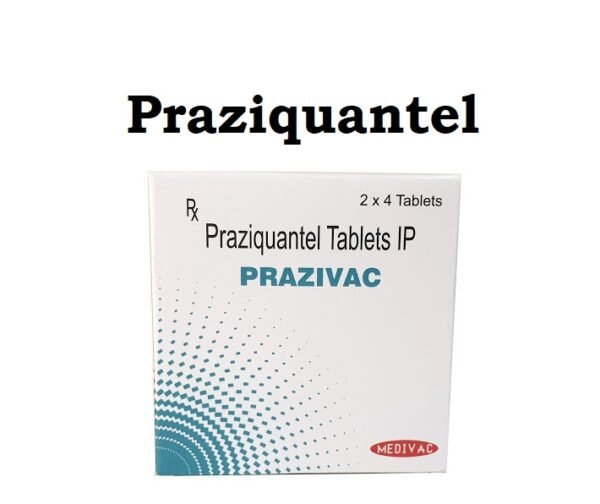Praziquantel (Biltricide) is an antihelminthic medicine that is used to treat most infections caused by cestodes and schistosomes.
Praziquantel Uses:
-
Helminths:
- Treatment of infections in patients ≥1 year caused by the following species of Schistosoma:
- Schistosoma mekongi,
- S. japonicum,
- S. mansoni,
- S. hematobium) and the
- liver flukes (Clonorchis sinensis/ Opisthorchis viverrini)
- Treatment of infections in patients ≥1 year caused by the following species of Schistosoma:
-
Off-Label Use of Praziquantel in Adults:
- Neurocysticercosis, parenchymal;
- Tapeworms
Praziquantel Dose in Adults
Praziquantel Dose in the Treatment of Schistosomiasis:
-
Oral: Dosage of 20 mg/kg 3 times a day for one day, spaced 4- to 6 hours apart.
Praziquantel Dose in the treatment of Clonorchiasis/ opisthorchiasis:
-
Oral: 3 times a day for 1 to 2 days at a dose of 25 mg/kg.
Praziquantel Dose in the treatment of parenchymal Neurocysticercosis (>2 viable cysts) (off-label):
- Oral:
- For 10 to 14 days, administer 50 mg/kg/day in three evenly spaced doses (in conjunction with albendazole); repeat the dose if 6-month follow-up imaging reveals persistent viable lesions.
-
Note:
- Before beginning antiparasitic therapy, begin adjunctive corticosteroid therapy.
- Patients with untreated hydrocephalus, calcified lesions, or cysticerci encephalitis should not get antiparasitic therapy; instead, an infectious disease specialist should be consulted for particular therapeutic advice.
Praziquantel Dose in the treatment of Tapeworms (off-label):
- Oral: As a single stat dosage, administer 5 to 10 mg/kg (25 mg/kg for Hymenolepis nana).
Praziquantel Dose in Children:
- Note: The period between doses is highly variable and depends on the patient's condition; intervals of 4 to 6 hours are recommended for doses given three times daily.
Praziquantel Dose in the Treatment of Flukes:
Clonorchiasis (Clonorchis sinensis or Chinese liver fluke); Opisthorchiasis (Opisthorchis viverrini or Southeast Asian liver fluke):
-
Children and Adolescents:
- Oral: Dosage of 25 mg/kg For one to two days, 3 times per day at 4- to 6-hour intervals.
Fasciolopsiasis (Fasciolopsis buski [intestinal fluke]):
-
Children and Adolescents:
- Oral: 3 doses of 25 mg/kg per day for one day.
Paragonimiasis (Paragonimus spp. or lung fluke]):
-
Children and Adolescents:
- Oral: Dosage of 25 mg/kg 3 times every day for two to three days.
Praziquantel Dose in the treatment of Schistosomiasis (Bilharziasis):
Treatment (CDC 2018c; Red Book [AAP 2018]):
- Note: Dosage of 25 mg/kg 3 times every day for two to three days.
Schistosoma japonicum and Schistosoma mekongi:
-
Children and Adolescents:
- Oral: 20 mg/kg/dose 3 times a day for 1 day
Schistosoma mansoni, Schistosoma haematobium, and Schistosoma intercalatum:
-
Children and Adolescents:
- Oral: 20 mg/kg/dose twice a day for 1 day
Control programs for endemic areas:
-
Infants, Children, and Adolescents:
- Oral:
- A single dose of 40 mg/kg has been used successfully to treat S. mansoni in the population that included infants (aged 5 months to 7 years) and urogenital S. haematobium in children aged 1 to 10; however, pharmacokinetic evidence indicates a decreased cure rate in young children and infants.
- One argument is that younger patients may need higher dosages due to pharmacokinetic/dynamic variations.
- For example, in young children, a single dose of 60 mg/kg was successfully utilised to treat S.mansoni in children between the ages of 3 and 8 in a hyperendemic location.
- Oral:
Praziquantel Dose in the Treatment of Tapeworms:
Praziquantel for the treatment of the intestinal (Adult) stage of Diphyllobothrium latum (fish tapeworm), Taenia saginata (beef tape worm), Taenia solium (pork tapeworm):
-
Children and Adolescents:
- Oral: 5 to 10 mg/kg as a single stat dose
Praziquantel for the treatment of the intestinal stage (adult stage) of Dipylidium caninum:
-
Infants ≥6 months, Children, and Adolescents:
- Oral: 5 to 10 mg/kg as a single stat dose
Praziquantel for the treatment of Hymenolepis nana (dwarf tapeworm):
-
Children and Adolescents:
- Oral: 25 mg/kg as a single dose
Praziquantel for tissue stage (larva stage) of Neurocysticercosis (Taenia solium or pork tapeworm):
-
Children and Adolescents:
- Oral: 50 mg/kg/day for 15 days.
- Note: May be used in conjunction with antiseizure medication and/or corticosteroids.
Praziquantel Pregnancy Category: B
- According to available data, there has been no evidence of an increase in maternal or fetal outcomes after the use of Praziquantel during Schistosoma treatment.
- The World Health Organization recommends that pregnant women receive praziquantel in areas where soil-transmitted and schistosomiasis are common.
- Neurocysticercosis non-emergent treatment may be delayed until after the pregnancy is over.
Praziquantel use during breastfeeding:
- Breast milk contains Praziquantel.
- One study found that breast milk concentrations of praziquantel 50mg/kg or three 20mg/kg doses were 1% after maternal use.
- According to the manufacturer breastfeeding during therapy is a decision that should be made after considering the risks to infants and the benefits to mothers.
- The World Health Organization considers that praziquantel is compatible with breastfeeding females.
Praziquantel Dose in Kidney Disease:
- No dosage adjustment is necessary.
Praziquantel Dose in Liver Disease:
- There are no dosage adjustments provided in the manufacturer's labeling.
- However, total drug exposure in moderate-to-severe impairment is increased.
- Occurrence and/or severity may be increased in patients with a high worm burden.
Side effects of Praziquantel
-
Central nervous system:
- Dizziness
- Headache
- Malaise
-
Dermatologic:
- Urticaria
-
Gastrointestinal:
- Abdominal distress
- Nausea
-
Miscellaneous:
- Fever
Contraindications to Praziquantel:
- Hypersensitivity to the primary drug
- ocular cysticercosis;
- a concomitant prescription with strong cytochrome P450 (CYP450) inducers, such as rifampin
Warnings and precautions
-
Cardiac arrhythmias:
- During treatment, monitor patients suffering from arrhythmias;
- Praziquantel administration has been linked to a variety of conditions including ectopic rhythms and ventricular fibrillation.
-
Effects on central nervous system:
- Praziquantel could be used to treat central nervous system disorders such as paragonimiasis or schistosomiasis.
- Think about whether patients who have previously experienced seizures or other symptoms that could point to central nervous system involvement, including subcutaneous nodules that could point to cysticercosis, are at a higher risk.
-
Hepatic impairment
- Take care when you have moderate or severe hepatic impairment.
- Praziquantel plasma concentrations could increase as a result of impaired liver drug metabolism.
-
Neurocysticercosis:
- Use only as directed: By triggering an inflammatory reaction, antiparasitic therapy can make the symptoms of neurocysticercosis worse.
- It is important to start adjunctive corticosteroid treatment before you begin antiparasitic therapies.
- Untreated hydrocephalus, cysticerci, and calcified lesions should not be treated with antiparasitic treatment.
- To exclude intraocular cysticerci, perform a funduscopic examination before initiating antiparasitic treatment. In some cases of unsuspected intraocular parasites, antiparasitic treatment may result in blindness.
-
Schistosomiasis:
- Praziquantel might not have any effect on migratory Schistosomulae
- Praziquantel may not be useful in treating the acute phase, according to observational data.
- Additionally, use in schistosomiasis patients may be linked to clinical side effects such as paradoxical reactions or serum sickness. An abrupt inflammatory immunological response known as a Jarisch-Herxheimer-like reaction is most likely brought on by the release of schistosomal antigens.
- The acute period is when these reactions occur most frequently. They may result in potentially fatal conditions such as respiratory failure, encephalopathy, and papilledema.
Praziquantel: Drug Interaction
Note: Drug Interaction Categories:
- Risk Factor C: Monitor When Using Combination
- Risk Factor D: Consider Treatment Modification
- Risk Factor X: Avoid Concomitant Use
Risk Factor C (Monitor therapy) |
|
|
May elevate CYP3A4 substrates' serum concentration (High risk with Inhibitors). |
|
|
May elevate CYP3A4 substrates' serum concentration (High risk with Inhibitors). |
|
|
Praziquantel serum concentration can drop. |
|
|
Praziquantel serum concentration can drop. |
|
|
Clofazimine |
May elevate CYP3A4 substrates' serum concentration (High risk with Inhibitors). |
|
CYP3A4 Inducers (Moderate) |
May decrease the serum concentration of CYP3A4 Substrates (High risk with Inducers). |
|
CYP3A4 Inhibitors (Strong) |
May increase the serum concentration of Praziquantel. |
|
May decrease the serum concentration of CYP3A4 Substrates (High risk with Inducers). |
|
|
May increase the serum concentration of CYP3A4 Substrates (High risk with Inhibitors). |
|
|
May decrease the serum concentration of CYP3A4 Substrates (High risk with Inducers). |
|
|
May increase the serum concentration of CYP3A4 Substrates (High risk with Inhibitors). |
|
|
May increase the serum concentration of CYP3A4 Substrates (High risk with Inhibitors). |
|
|
Fosnetupitant |
May increase the serum concentration of CYP3A4 Substrates (High risk with Inhibitors). |
|
Grapefruit Juice |
May increase the serum concentration of Praziquantel. |
|
May decrease the serum concentration of CYP3A4 Substrates (High risk with Inducers). |
|
|
May increase the serum concentration of CYP3A4 Substrates (High risk with Inhibitors). |
|
|
Netupitant |
May increase the serum concentration of CYP3A4 Substrates (High risk with Inhibitors). |
|
May increase the serum concentration of CYP3A4 Substrates (High risk with Inhibitors). |
|
|
May decrease the serum concentration of CYP3A4 Substrates (High risk with Inducers). |
|
|
May decrease the serum concentration of CYP3A4 Substrates (High risk with Inducers). |
|
|
May increase the serum concentration of CYP3A4 Substrates (High risk with Inhibitors). |
|
|
May decrease the serum concentration of CYP3A4 Substrates (High risk with Inducers). |
|
Risk Factor D (Consider therapy modification) |
|
|
Dabrafenib |
May lower the serum level of CYP3A4 substrates (High risk with Inducers). Management: When possible, look for substitutes for the CYP3A4 substrate. If concurrent therapy cannot be avoided, pay special attention to the substrate's clinical consequences (particularly therapeutic effects). |
|
Lorlatinib |
May decrease the serum concentration of CYP3A4 Substrates (High risk with Inducers). Management: Avoid concurrent use of lorlatinib with any CYP3A4 substrates for which a minimal decrease in serum concentrations of the CYP3A4 substrate could lead to therapeutic failure and serious clinical consequences. |
|
May increase the serum concentration of CYP3A4 Substrates (High risk with Inhibitors). Management: Minimize doses of CYP3A4 substrates, and monitor for increased concentrations/toxicity, during and 2 weeks following treatment with mifepristone. Avoid cyclosporine, dihydroergotamine, ergotamine, fentanyl, pimozide, quinidine, sirolimus, and tacrolimus. |
|
|
St John's Wort |
May decrease the serum concentration of CYP3A4 Substrates (High risk with Inducers). Management: Consider an alternative for one of the interacting drugs. Some combinations may be specifically contraindicated. Consult appropriate manufacturer labeling. |
|
May increase the serum concentration of CYP3A4 Substrates (High risk with Inhibitors). Management: Use of stiripentol with CYP3A4 substrates that are considered to have a narrow therapeutic index should be avoided due to the increased risk for adverse effects and toxicity. Any CYP3A4 substrate used with stiripentol requires closer monitoring. |
|
Risk Factor X (Avoid combination) |
|
|
Conivaptan |
May elevate CYP3A4 substrates' serum concentration (High risk with Inhibitors). |
|
CYP3A4 Inducers (Strong) |
Praziquantel serum concentration can drop. Treatment: Praziquantel should not be used in conjunction with potent CYP3A4 inducers. Rifampin should be stopped 4 weeks before starting praziquantel therapy. The day after the last dose of praziquantel, rifampin may be started again. |
|
Fusidic Acid (Systemic) |
May increase the serum concentration of CYP3A4 Substrates (High risk with Inhibitors). |
|
May increase the serum concentration of CYP3A4 Substrates (High risk with Inhibitors). |
|
Monitoring parameters:
-
Liver function tests
-
cardiac irregularities
-
seizures
-
culture urine or feces for ova before instituting therapy
How to administer Praziquantel?
- When eating, take the pills with water.
- The bitter taste of the tablets should be quickly taken to prevent gagging or vomiting.
- Do not chew the tablet; it may be cut in half or quarters.
- Tablets can be broken up or dissolved, then combined with semi-solid food or liquid; however, this mixture should be consumed within an hour.
- The scored tablets can be divided into four pieces, each containing 150 mg.
Mechanism of action of Praziquantel:
Praziquantel makes calcium more permeable to cells in schistosomes. This leads to strong muscle spasms and worm paralysis.
As a result, suckers are detached from blood vessel walls and knocked loose.
Absorption:
- Oral: 80%
Distribution:
- CSF concentrations range from 14% to 20% of plasma levels.
Protein binding:
- ~80%
Metabolism:
- Significant first-pass impact; liver metabolizes to hydroxylated and conjugated metabolites
Half-life elimination:
- Parent drug: 0.8 to 1.5 hours;
- Metabolites: 4.5 hours
Time to peak, serum:
- 1 to 3 hours
Excretion:
- Urine ~80% (>99% as metabolites)
International Brands of Praziquantel:
- Biltricide
- Belicide
- Biltricid
- Biltricide
- Cesol
- Cisticid
- Cysticide
- Distocide
- Droncit Vet
- Epiquantel
- Fluxide
- Kalcide
- Opticide
- Prasikon
- Prazine
- Praziquin
- Prazite
- Prazitral
- Vermaqpharma Vet
- Wormicide
Praziquantel Brand Names in Pakistan:
Not available.




